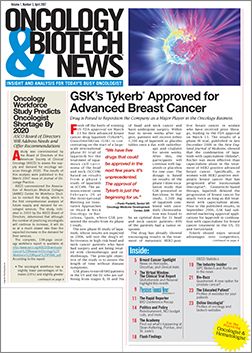Publication
Article
OBTN
Oncology Workforce Study Predicts Oncologist Shortage By 2020
Author(s):
A study was commissioned by the Board of Directors of the American Society of Clinical Oncology (ASCO) to assess the supply and demand for oncology services through 2020.
Click here to view as PDF.
COVER STORY
Oncology Workforce Study Predicts Oncologist Shortage By 2020
ASCO Board of Directors Will Address Needs and Offer Recommendations
A
study was commissioned by the Board of Directors of the American Society of Clinical Oncology (ASCO) to assess the supply and demand for oncology services through 2020. The results of this analysis were published in the March 2007 issue of Journal of Oncology Practice.
ASCO commissioned the Association of American Medical Colleges (AAMC) Center for Workforce Studies to conduct the study, which is the first comprehensive analysis of future supply and demand for oncologist services. The study, initiated in 2003 by the ASCO Board of Directors, determined that although the number of practicing oncologists will continue to increase, it will do
so at a much slower rate than the expected increase in the demand for their services.
The complete, 138-page oncology workforce report is available at http://www.asco.org/ASCO/Downloads/Cancer%20Research/Oncology%20Workforce%20Report%20FINAL.pdf.
According to the report:
• The oncologist workforce has a
slightly lower percentages of females
(24%) and slightly greater
percentages of international medical graduates
(29%) than the full physician workforce,
which is 27% female and 25% international
medical graduates.
• More than half (54%) of currently practicing
oncologists ≥50 years of age and will be
≥65 years of age by 2020.
• Most oncologists (57%) work in private
practice settings, 32% in academic settings,
and the balance are in government
(2.4%), industry (2.4%), or other settings
(5.6%).
• Roughly 500 fellows a year complete an
oncology fellowship in one of the three specialties
modeled in the study and oncology
program directors report limited plans to increase
the number of training slots between
now and the 2010-2011 academic year.
Based on the results of the study, the researchers project a significant shortage of medical and gynecologic oncologists in the US by 2020. The study found that an aging and growing population, increasing numbers of cancer survivors, and slower growth in the supply of oncologists will result in a shortage of 2,550 to 4,080 oncologists by 2020. At that time, the total supply of oncologists is projected to be roughly 12,500. The growth in demand for services will be driven primarily by the 48% growth in the US population older than age 65 and the 81% growth in the number of cancer survivors.
Addressing the projected shortfall will require a comprehensive strategy to ensure that Americans have access to oncology services in 2020. As a result of the study, ASCO has formed a Workforce Implementation Group to identify the specific actions ASCO should undertake to address the projected shortfall. The Group is chaired by Michael Goldstein, MD (Beth Israel Deaconess Medical Center, Boston), and co-chaired by Dean Bajorin, MD (Memorial Sloan-Kettering Cancer Center, New York). The implementation group will initially focus on the developing fellowship programs and joint initiatives with non-physician oncology and primary physician groups, providing guidance and technical support to ASCO members to increase productivity and efficiency, and ongoing collection of workforce data to monitor trends to help prevent shortfalls. Recommendations from the Workforce Implementation Group are expected later this year.
According to Dr. Goldstein, “It is very important that the results of the study are looked at not as a problem only for medical oncology. It really presents a challenge for the whole cancer care delivery system, including nurses, surgeons, radiation oncologists, pharmacists, and anyone who participates in the care of patients with cancer.”
The results of the oncology workforce study are not surprising. Specialist shortages have been predicted before. For example, Dr. R.A. Cooper of the Health Policy Institute, Medical College of Wisconsin, Milwaukee, Wisconsin cited his own research (Cooper RA. There is a shortage of specialists: is anyone listening? Acad Med. 2002;77:761-766) in predicting that the US
will experience progressively more severe shortages of specialists. In addition, Dr. Cooper cited a wide variety of anecdotal evidence indicating that such shortages are beginning to appear already. He recommends that attention be directed to training more specialists, but cautions against a further dependence on international medical graduates to fill the gap. Instead, he calls upon academic medicine to expand the infrastructure for medical education. It will be interesting to see whether the ASCO Workforce Implementation Group will issue similar recommendations.
It is likely that a combination of initiatives will be needed to prevent the predicted shortage of oncologists and oncology services. As the researchers themselves noted in the Journal of Oncology Practice article, “There are opportunities to reduce the gap between projected supply and demand by increasing the number of oncology training slots and by increasing the use of other practitioners such as NPs or PAs, PCPs, and hospice care providers.”
